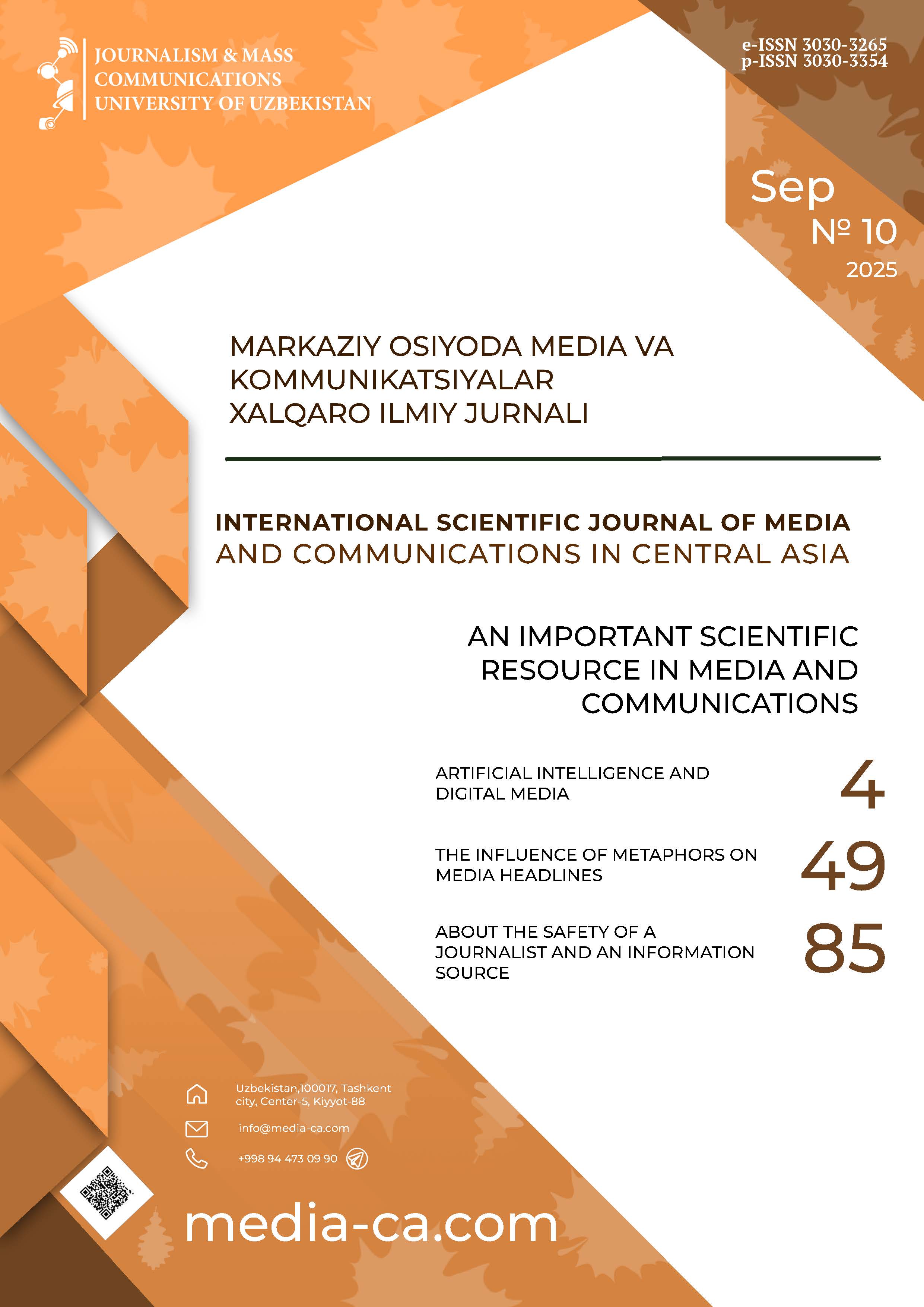Статьи
INTERSECTIONS OF ARTIFICIAL INTELLIGENCE AND JOURNALISM: TRANSFORMATION, RISKS, AND OPPORTUNITIES IN THE MEDIA ENVIRONMENT
Published 2025-10-04
Keywords
- artificial intelligence,
- journalism,
- human-AI collaboration,
- digital technologies,
- transformation
- information and communication ...More
How to Cite
DAVLATOVA , N., QODIROVA , U., UZOQOVA , U., & ELMURODOVA , N. (2025). INTERSECTIONS OF ARTIFICIAL INTELLIGENCE AND JOURNALISM: TRANSFORMATION, RISKS, AND OPPORTUNITIES IN THE MEDIA ENVIRONMENT. INTERNATIONAL SCIENTIFIC JOURNAL OF MEDIA AND COMMUNICATIONS IN CENTRAL ASIA, (10). https://doi.org/10.62499/ijmcc.vi10.216
Abstract
The article examines the impact of rapidly evolving artificial intelligence (AI) technologies on journalism, with particular attention to the attitudes towards AI adoption in Uzbek journalism. It emphasizes both the benefits and risks of these technologies as well as the potential ethical dilemmas they create. The study explores the extent to which AI is currently being applied in content creation, editing, and distribution, while also highlighting the opportunities and challenges emerging from these transformative processes. To achieve this, in-depth interviews were conducted with journalists, students, and focus groups
References
- Albizu-Rivas, I., Parratt-Fernández, S., & Mera-Fernández, M. (2024). Artificial intelligence in slow journalism: Journalists’ uses, perceptions, and attitudes. Journalism and Media, 5(4), 1836–1850. https://doi.org/10.3390/journalmedia5040111
- Artificial Intelligence Act. (2024). Official Journal of the European Union. Retrieved September 16, 2025 from https://artificialintelligenceact.eu/the/act/
- Dentons: AI in 2023: Key trends and developments. Retrieved September 16, 2025 from: https://www.dentons.com/en/insights/articles/2023/january/20/ai-in-2023-key-trends-and-developments/
- Dörr, K. N. (2016). Mapping the field of algorithmic journalism. Digital Journalism, 4(6), 700–722. https://doi.org/10.1080/21670811.2015.1096748
- Fanta, A. & Dachwitz, I. (2020). Google, the media patron: How the digital giant ensnares journalism. Otto Brenner Foundation. Retrieved September 16, 2025 from: https://www.otto-brenner-stiftung.de/fileadmin/user_data/stiftung/02_Wissenschaftsportal/03_Publikationen/AH103_Google_EN.pdf
- Kim, S.W., Kong, J.H., Lee, S.W. et al. (2022). Recent Advances of Artificial Intelligence in Manufacturing Industrial Sectors: A Review. Int. J. Precis. Eng. Manuf. 23, 111–129. https://doi.org/10.1007/s12541-021-00600-3
- Lopezosa, C., Codina, L., Pont-Sorribes, C., Vállez, M. (2023). Use of generative artificial intelligence in the training of journalists: challenges, uses and training proposal. Profesional de la información, 32(4). https://doi.org/10.3145/epi.2023.jul.08
- McCarthy, J., Minsky, M., Rochester, N., & Shannon, C. (1956). A proposal for the Dartmouth summer research project on artificial intelligence. Dartmouth College. Retrieved September 16, 2025 from: https://ojs.aaai.org/aimagazine/index.php/aimagazine/article/view/1904
- Opdahl, A., Tessem, B., Dang-Nguen, D.-T., Motta, E., Setty, V., Throndsen, E., Tverberg, F., Trattner, C. (2023). Trustworthy journalism through AI. Data & Knowledge Engineering, 146(102182), https://doi.org/10.1016/j.datak.2023.102182
- Porlezza, C. (2019). Book Review: Nicholas Diakopoulos, Automating the news: How algorithms are rewriting the media. Journalism, 20(10), 1417-1419. doi: 10.1177/1464884919876179
- Pasquale, F. (2016). The black box society: The secret algorithms that control money and information. Harvard University Press. Retrieved September 16, 2025 from: https://raley.english.ucsb.edu/wp-content/Engl800/Pasquale-blackbox.pdf
- Rahman, M. A. (2024). Artificial intelligence in journalism: A comprehensive review. Journal of Scientific Reports, 6(1), 56–65. IJSAB International. Retrieved September 16, 2025 from: https://ideas.repec.org/a/aif/report/v6y2024i1p56-65.html
- Reddit is main source for LLM. (2025). Reddit.com. Retrieved September 16, 2025 from https://www.reddit.com/r/IndiaTech/comments/1mmjhn7/reddit_is_the_top_source_for_llms/?tl=ru
- Salian, I. (2018). SuperVize Me: What’s the Difference Between Supervised, Unsupervised, Semi-Supervised and Reinforcement Learning? (2018). Retrieved September 16, 2025: https://blogs.nvidia.com/blog/supervised-unsupervised-learning/
- Sonni, A. F., Hafied, H., Irwanto, I., & Latuheru, R. (2024). Digital newsroom transformation: A systematic review of the impact of artificial intelligence on journalistic practices, news narratives, and ethical challenges. Journalism and Media, 5(4), 1554–1570. https://doi.org/10.3390/journalmedia5040097
- Schneider, É. (2018). Nick COULDRY et Andreas HEPP (2016), “The Mediated Construction of Reality”. Communication, 35(1). https://doi.org/10.4000/communication.7460
- Hasanov, D. & Shirinboyеv, R. (2024). 2024: sun’iy intellekt nazariyasi va amaliyoti: tajribalar, muammolar va istiqbollar. Respublika ilmiy-amaliy konferensiyasi. Qayta olindi: 2025-yil 16-sentabr https://dtai.tsue.uz/index.php/sinatmi/ru/article/view/dh
- O‘zbekistonda sun’iy intellekt haqida qonun qabul qilinmoqda. Unda nima yozilgan? (2025). Kun.uz. Qayta olindi: 2025-yil 16-sentabr https://kun.uz/news/2025/04/15/ozbekistonda-suniy-intellekt-haqida-qonun-qabul-qilinmoqda-unda-nima-yozilgan
- Sun'iy intellekt va jurnalistikaning kesishgan nuqtalari: Media muhitda transformatsiya, xavf va imkoniyatlar. So’rovnoma (2025). Qayta olindi: 2025-yil 16-sentabr https://docs.google.com/forms/d/e/1FAIpQLSfsT5lJ7huXejt8isa6Jxm8Ift_XkgKYVP0JKFu1X8tzcvSeA/viewform?usp=dialog


